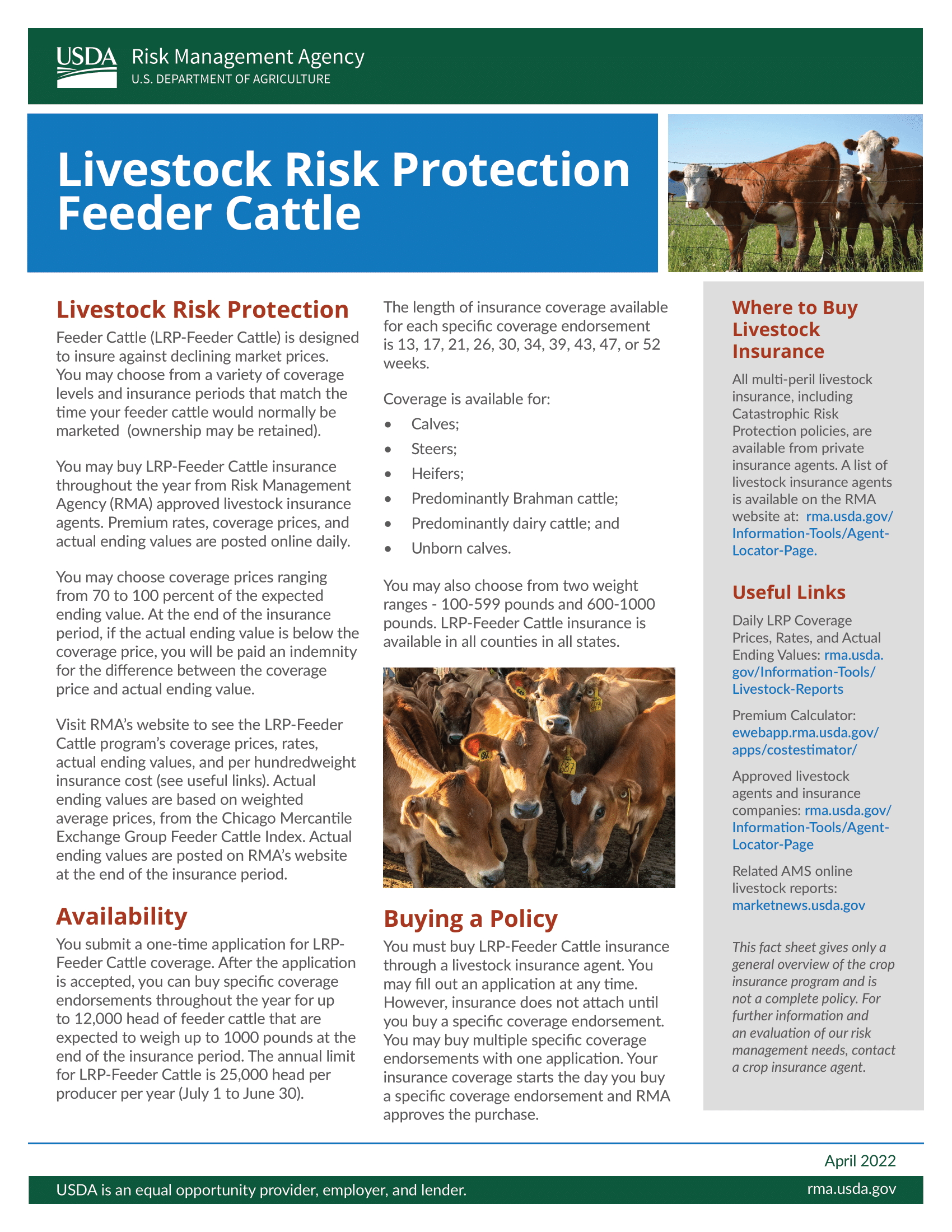Elevate Your Competence with Bagley Risk Management
Elevate Your Competence with Bagley Risk Management
Blog Article
Comprehending Animals Threat Defense (LRP) Insurance Policy: A Comprehensive Overview
Navigating the world of livestock danger security (LRP) insurance coverage can be a complicated undertaking for lots of in the agricultural market. From how LRP insurance policy operates to the numerous insurance coverage options available, there is much to uncover in this extensive guide that could potentially shape the way livestock producers approach threat management in their companies.

How LRP Insurance Functions
Periodically, comprehending the mechanics of Animals Danger Protection (LRP) insurance policy can be complicated, but damaging down how it functions can give clearness for breeders and farmers. LRP insurance coverage is a danger monitoring device created to safeguard animals producers versus unanticipated rate decreases. The policy enables producers to set an insurance coverage level based upon their particular needs, selecting the variety of head, weight range, and insurance coverage price. As soon as the plan is in area, if market value drop listed below the protection rate, producers can sue for the difference. It is essential to note that LRP insurance is not a profits guarantee; rather, it focuses only on price threat security. The insurance coverage period generally varies from 13 to 52 weeks, offering adaptability for producers to choose a period that straightens with their manufacturing cycle. By utilizing LRP insurance coverage, farmers and ranchers can alleviate the financial dangers connected with varying market prices, making certain higher stability in their procedures.
Eligibility and Protection Options

When it comes to insurance coverage choices, LRP insurance supplies producers the versatility to pick the coverage degree, protection period, and recommendations that finest fit their threat management requirements. Insurance coverage levels commonly range from 70% to 100% of the anticipated finishing value of the insured livestock. Manufacturers can also choose coverage durations that straighten with their manufacturing cycle, whether they are guaranteeing feeder livestock, fed cattle, swine, or lamb. Endorsements such as cost danger security can better customize insurance coverage to protect against adverse market fluctuations. By comprehending the eligibility standards and insurance coverage alternatives available, animals manufacturers can make enlightened choices to take care of threat properly.
Advantages And Disadvantages of LRP Insurance Coverage
When examining Livestock Danger Protection (LRP) insurance policy, it is essential for animals manufacturers to evaluate the benefits and drawbacks intrinsic in this risk monitoring device.

One of the main benefits of LRP insurance policy is its capacity to offer security against a decline in livestock more tips here prices. Furthermore, LRP insurance provides a level of adaptability, allowing producers to personalize protection levels and policy durations to fit their certain requirements.
One constraint of LRP insurance policy is that it does not safeguard against all kinds of risks, such as disease outbreaks or all-natural More Info catastrophes. It is vital for producers to thoroughly analyze their individual threat exposure and economic situation to determine if LRP insurance policy is the ideal risk monitoring tool for their procedure.
Comprehending LRP Insurance Premiums

Tips for Optimizing LRP Benefits
Optimizing the advantages of Livestock Risk Security (LRP) insurance policy YOURURL.com requires tactical planning and positive threat management - Bagley Risk Management. To maximize your LRP insurance coverage, consider the complying with pointers:
On A Regular Basis Evaluate Market Problems: Keep informed about market trends and cost variations in the animals industry. By monitoring these aspects, you can make educated decisions regarding when to buy LRP insurance coverage to protect against potential losses.
Set Realistic Coverage Degrees: When picking insurance coverage degrees, consider your manufacturing prices, market price of animals, and prospective dangers - Bagley Risk Management. Setting reasonable protection levels ensures that you are appropriately protected without paying too much for unneeded insurance coverage
Diversify Your Protection: Instead of relying solely on LRP insurance policy, take into consideration expanding your danger management strategies. Combining LRP with other threat monitoring tools such as futures agreements or alternatives can supply extensive coverage versus market uncertainties.
Review and Readjust Protection Frequently: As market conditions transform, periodically review your LRP protection to ensure it straightens with your present risk exposure. Readjusting coverage levels and timing of acquisitions can aid enhance your risk security strategy. By adhering to these suggestions, you can optimize the benefits of LRP insurance and secure your livestock procedure versus unexpected threats.
Final Thought
Finally, livestock danger defense (LRP) insurance coverage is a valuable device for farmers to take care of the financial dangers associated with their livestock procedures. By understanding exactly how LRP functions, eligibility and coverage choices, along with the advantages and disadvantages of this insurance coverage, farmers can make enlightened choices to safeguard their resources. By carefully thinking about LRP costs and applying strategies to optimize advantages, farmers can mitigate potential losses and guarantee the sustainability of their operations.
Livestock manufacturers interested in getting Animals Threat Defense (LRP) insurance can explore a variety of eligibility standards and insurance coverage options customized to their specific animals procedures.When it comes to coverage options, LRP insurance provides manufacturers the adaptability to choose the coverage level, coverage duration, and recommendations that ideal match their danger administration requirements.To understand the complexities of Livestock Risk Protection (LRP) insurance totally, recognizing the variables affecting LRP insurance coverage premiums is essential. LRP insurance premiums are established by different aspects, including the coverage degree selected, the expected rate of animals at the end of the protection duration, the kind of livestock being guaranteed, and the size of the coverage duration.Evaluation and Adjust Insurance Coverage Consistently: As market problems change, occasionally examine your LRP coverage to guarantee it aligns with your existing danger exposure.
Report this page